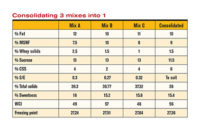The annual supply and demand for vanilla are normally in “precise” balance with each other.
Given that it takes vanilla three years to flower and produce beans, any disruption in supply endangers the delicate balance between supply and demand, creating long periods of market uncertainty, speculation, rapidly rising demand, tightening of supplies, escalating prices and poor quality of flavor as immature beans enter the market. Such is the case today.
Sound familiar? It’s happened before. We revisit the recommendations made in 2000 and 2004 that are now all too applicable in 2016 and beyond.
With demand outstripping supply, the use of immature beans for extraction yields less than desirable flavor, aroma and taste. In high-moisture beans, microbiological changes can also be reflected in poor-quality flavor.
Vanilla differs by region
Various vanilla-growing regions (Madagascar, Indonesia, Mexico, Tahiti and the like) do not deliver the same flavor quality. Therefore, they are not able to be considered alternative sources of any given vanilla flavor profile used in any given ice cream.
So, as crops in these areas, which may be on different growing cycles, falter in quality or volume, market pressures quickly translate to introduction into the supply chain additional immature beans of fundamentally differing flavor profiles, even in the best of crop years.
Dairy foods use nearly 70% of all vanilla extract produced. At greatest risk are Category I (“vanilla”) and Category II (“vanilla-flavored”) ice creams. Vanilla extract constitutes all or a significant percent of added flavor. “Artificially flavored vanilla” ice creams (Category III) are not affected.
Managing taste and flavor quality are critical to achieve sensory targets. In many cases, taste and flavor are tied closely to brand identities and acceptability. Lest we forget, vanilla also can be used to enhance or provide qualitative support to other characterizing flavors.
Ask these questions
What are the options? Look at the real need for a specific vanilla extract in all formulas, including non-ice cream products. Can that extract be totally or partially replaced with some other variant, replacer or enhancer? Can vanilla extract be spared in one product but used in another?
Consider sparing vanilla extract where vanilla is not the characterizing flavor. Pay careful attention to labeling requirements and packaging changes along the way. Can the amount and/or type of vanilla extract(s) be modified?
Modifications to mix composition can assist. Such modifications should focus on the influence of components that might negatively modify the perception of any given vanilla flavor profile. Consider the influence from the amount and type of corn sweeteners, total sweetness, total solids, amount/type of fats and serum solids, including whey ingredients.
For example, low D.E. (dextrose equivalent) corn syrups, great for managing the behavior of water and textural qualities can, at the same time, “mute” the delivery of a fresh, “crisp,” fine vanilla flavor.
High molecular weight proteins can interfere with the release of the fine volatiles of vanilla, directly modifying the quality, intensity, order and rate at which multiple volatile flavors are released during consumption.
Fat plays a factor as the subtle carrier of many of vanilla’s background volatiles, and it, too, impacts the desired release of volatile flavors compatible with overall sensory appeal. Don’t forget the impact of color and appearance in the perception (quality and intensity) of any flavor. In addition, carefully consider the flavor of the mix components themselves and any secondary masking effects on flavor quality under the influence of freeze concentration.
Most importantly, work closely with your suppliers.
As noted nearly 15 years ago, and unfortunately true today, this is not a short-term situation. It will happen again. Consider a long-term plan. Take time. Do it right.
For more on vanilla and nuances related to mix composition and flavor delivery, attend a “Tharp & Young on Ice Cream: Technical Short Courses, Workshops and Clinics”. Details at www.onicecream.com or call 281-782-4536 or 610-975-4424.
Factors in the price increase
The following is from the 2016 Vanilla Market Update, courtesy of David Michael & Co.:
For 2015-16, a combination of non-weather related factors, including abnormally small crop due to poor flowering (predicted to be 55-65% below normal); quality of beans noted to be the worse in years; low prices in 2010-2013, leading farmers to consider more lucrative crops; early vacuum-packing of immature and/or high moisture beans; extractors in need of beans to replenish exhausted supplies; major purchases of vanilla beans using monies from illegal trade practices; and major market uncertainty/speculation are disrupting the fragile balance between ever-tightening supplies and rising demand for the world’s most popular flavor.
The result is substantial increases in the cost of vanilla beans, and, thus, vanilla extract made from those beans.



